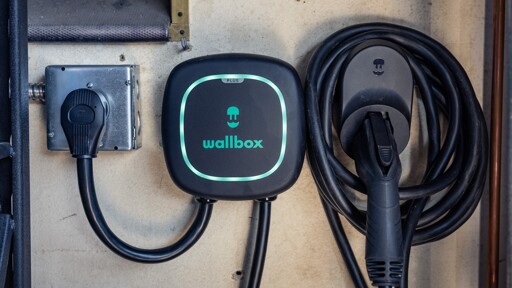- cross-posted to:
- technology@beehaw.org
- cross-posted to:
- technology@beehaw.org
Yes, it’s total BS.
I’ll also share the flip side here, though, from https://electricaleducator.com/for-homeowners/nema-14-50-what-you-need-to-understand/ :
I spoke to Leviton and the general consensus is that the receptacles are not being installed correctly. Additionally, EV chargers draw a load for a longer period of time than a normal appliance. Homeowners and even some electricians are not using the necessary torqueing tools. Terminals that are too loose and, yes, too tight, will fail. Leviton came out with an upgraded version for EV chargers that we will do a deep dive on. If you’re installing an EV Charger, you should probably opt for the more robust Leviton product.
So, it is more dangerous than other appliances, and I’ve never seen an inspector check tightness. That said, I totally agree that it is unlikely to deter someone from installing one and more likely that people will do a shit job and it’ll be done without someone checking it. So, pretty bad either way, honestly.
Hubbell has one, too.
A relevant “dishwasher guy” video just came out this week.
I used one of these cheap plugs for installing my MIL’s EV charger before I heard of the issues. However, It’s been fine because I under-utilized it due to the continuous load. I’m using it on a 40 amp circuit (code allows for this, as there is no 40 amp receptacle, so these plugs are allowed in this situation) with a 40 amp breaker and the charger is set to “40 amps”, which is really 32 amps, via dip switches, so it’s drawing 80% of 80% of 50 amps.
Given the problems I’ve heard, though, I might just change it up and just hard wire it, even if I’m almost certainly fine anyway.
Almost nobody actually needs a 50 amp charger, unless you’re driving something like a Hummer EV. As long as you’re charging at 230V, a 15-20 amp draw is PLENTY for 99% of situations. Even at that lower amperage, most cars would charge from close to dead to 100% in less than 12 hours and the majority of people only discharge above 60-70% on their daily commute. Even a 110V 15 amp outlet can handle charging that overnight.
Technology Connections has been turning this horse to glue and hopefully it’ll start sticking soon.
Most people don’t drive more than a 15A outlet can charge overnight, most days. The solution for the biggest chunk of drivers is a standard household outlet.
A “dryer outlet” probably more than handles 98% of drivers.
We have this mentality from driving ICE cars so long that we gotta bring it down to E and then fill it up quick so we can get on with our day. No. Treat it like your cell phone. Charge it up slow when you aren’t using it.
Yup. I had to break this habit with my Mother-in-Law. She would park her car at home and not plug it in, then get range anxiety after a few days of that.
I printed and laminated a “Did you plug your car in?” and put it beneath her alarm panel, so when she armed it at night she’d remember to go plug it in, if she forgot when she got home.
Even a 110V 15 amp outlet can handle charging that overnight.
This is something I wish more people realized. If it doesn’t fully charge you overnight, it’ll get you close, and it’ll likely be enough for your daily commute. It also generates less heat and thus is better for the long-term health of your battery to trickle charge instead of fast-charging all the time.
Yeah even 20 amps at 230V is way less intense and is a good middle ground.
Permanently installed electric vehicle power transfer system equipment shall be installed by qualified persons.
This seems to indicate direct wired installations, which should only be done by a licensed electrician.
It could also indicate anything with a control box designed to be fixed in place. Basically anything that isn’t the portable 120v charge cable, because the 240v control boxes have to be “sized” appropriately to the specific circuit they are connected to to prevent the car from overdrawing power.
Yeah, it really does depend on how the municipality /state decides to read it, that’s the worst part. What’s the spirit here?
I feel like having a qualified person perform the installation is more important than the actual permit.
I understand why people don’t want this requirement though, it will add at least a couple hundred more dollars to the cost.
IMHO, though, a couple hundred dollars more up front, is worth the headaches down the road from a shitty install.
IMHO, though, a couple hundred dollars more up front, is worth the headaches down the road from a shitty install.
Unfortunately, it’s nothing but overhead cost for people who are sufficiently skilled and can follow electrical codes. Sigh.
My city specifically says, as a homeowner, I can do basic electrical without pulling permits. Now I’m in the South and I’ve rented houses which were internally wired with lamp cord - people can and will do some crazy fucking things. But my city doesn’t have an unusually high electrical fire rate.
As always on an old house tho - grandfathered in many ways - I point to things and say “it was like that when I bought it.” Why yes, I’m prepared to claim the EV hookup is part of the original 1902 electrical service.
There are plenty of people who are capable of grasping what the three wires (Or whatever the USA has) do and where and how to place and connect them, but there are also fuckwits.
My concern is that this change to the electrical code would impose needless expense on responsible people, while doing nothing to discourage the the irresponsible ones.
a couple hundred
Are electricians very cheap where you live? In the US Northeast, I was quoted several thousand for an EVSE install that was about 30’ from the breaker and had room in the panel. The hardware is only a couple hundred.
I think you meant to ask the person to whom I replied. The figure you quoted was from them.
Cheap 240-volt outlets are susceptible to overheating, which can start a fire.
Citation needed. Where does one buy an outlet like this? Certainly not from the big box store.
e: lol, motherfuckers downvoting for asking for a citation because I’m incredulous that a 240V outlet can’t handle what the circuit breaker can provide.
Citation needed. Where does one buy an outlet like this? Certainly not from the big box store.
Yep, Home Depot, Lowes, etc is where you’ll find them. They cost about $15 each.
These cheap outlets are okay for 240v loads that are only on for short periods of time at lower current, say 20A or maybe 30A. This would be fine for an electric clothes dryer for example. However, once you start pulling 40A through it for 5 or 6 hours, the minimal metal in the construction of the outlet can handle it, and they will literally melt from the heat. When they melt, they can cause fires.
The outlets that are built to handle the heat and current do exist but they cost $60 to $100 each. Also, putting an outlet in the garage requires GFCI. The cost of a regular 50A breaker is about $20. The GFCI version of the 50A breaker is $120. So folks looking to go cheap will buy the $15 outlet and the $20 breaker and set themselves up for multiple problems.
This is complete nonsense. Any UL listed plug will sustain a load indefinitely. There are millions of them running dryers in the US for hours at a time already.
This is complete nonsense.
You don’t need to take my word for it. Simply search “ev outlet melted” and you’ll get piles of results showing the gory melted results (just equipment, not people gore).
Charging a Tesla:

Charging an Audi:

Charging a Rivian:

People are finding the cheap NEMA 14-50 outlets just can’t handle the high current EV charging long term. The recommendation is for a Commercial grade NEMA 14-50 outlet instead of the cheap residential ones. Keep in mind the cheap ones work for weeks or months. Sometimes years, but this is the result of many of the cheap ones eventually.
Enphase/Clippercreek chargers actually ship with the high quality Commercial grade outlet specifically for this reason because they don’t want you buying one from Home Depot for $10 and damaging the charger or your home.
Any UL listed plug will sustain a load indefinitely. There are millions of them running dryers in the US for hours at a time already.
Home clothes dryers aren’t drawing 40A continuous current for 5-6 hours. Even when a clothes dryer is running for an hour its not drawing the full wire rated current. It cycles on and off the heating elements during the drying cycle.
There is no evidence that these are proper UL listed plugs or that they were installed correctly. There is tons of bootleg shit on Amazon that is clearly not up to code. The NEC is very specifically written with this exact situation in mind, which is why continuous current handling is the standard. The idea that there exists some lesser standards for home builds is a myth I’ve seen repeated over and over again and it simply is not true.
Is it possible that Home Depot’s supply chain is contaminated with knockoff parts? I guess. But the idea that there are somehow separate standards for home and commercial electrical fixtures, and that home Depot is selling people the former, inferior standard is absolutely, 100% nonsense.
Is it possible that Home Depot’s supply chain is contaminated with knockoff parts? I guess.
I never suggested anywhere that knockoffs were the cause.
The idea that there exists some lesser standards for home builds is a myth I’ve seen repeated over and over again and it simply is not true. But the idea that there are somehow separate standards for home and commercial electrical fixtures, and that home Depot is selling people the former, inferior standard is absolutely, 100% nonsense.
There are absolutely mechanical difference in residential and commercial constructed receptacles in general. Hospital grade being even higher.

Is it your belief that Home Depot and Leviton are simply fleecing uneducated buyers by charging more for “Designed for EV charging” NEMA 14-50 outlets?
Leviton “Designed for EV charging” NEMA 14-50 receptacle
…vs the cheap contractor grade outlet?
Leviton contractor grade NEMA 14-50 receptacle

How about Enphase/Clippercreek including their own NEMA 14-50 outlet which is a $60 Bryant receptacle? Why isn’t Enphase putting a $10 NEMA 14-50 in the box instead?

Here’s the official Enphase Training Installation video from the company (timestamped to the NEMA 14-50 receptacle instructions)
Enphase Training video timestamped to the NEMA 14-50 comment
“Even if you have a NEMA 14-50 already, Enphase is requiring you to replace that as we’ve seen some overheating from some older receptacles”
Is your assertion that Leviton and Enphase are just scaremongering unassuming consumers?
right? Are you a sparky? Sounds like some serious FUD to me.
Wait, WTF? Why can they sell that outlet? Got a link to the testing?
e: because basically you’re saying that my 50A breaker isn’t serving a 50A circuit for my dryer and my range. That’s fucked up. I know they don’t draw that much but the safety should be built in.
The safety is built in.
A 50 amp circuit should only be loaded to 80% of its rated load for continuous use (the NEC defines this as anything longer than 3 hours). So 50X0.8=40A is safe to draw for longer than 3 hours. The 20% buffer is there to account for load increases like the inrush current from a dryer heating element kicking on and off, or the motor starting and stopping.
Any receptacle rated for a 50 Amp circuit will also meet this requirement if installed properly. If you’re doing this shit, but a fucking torque wrench, because this shit does have torque requirements.
So a Home Depot plug can carry what it says it can and this article has FUD?
If it is UL listed, and installed properly: yes.
Installed properly means that the wire feeding it is sized properly and all connections are torqued to spec.
If listed receptacles weren’t designed for use at their rated amperage, then there’s no point of getting it tested and listed by an independent laboratory, and there would be many more electrical fires in factories than there are.
The problem is that most people will just slap the absolute cheapest shit they can find together however they feel.






